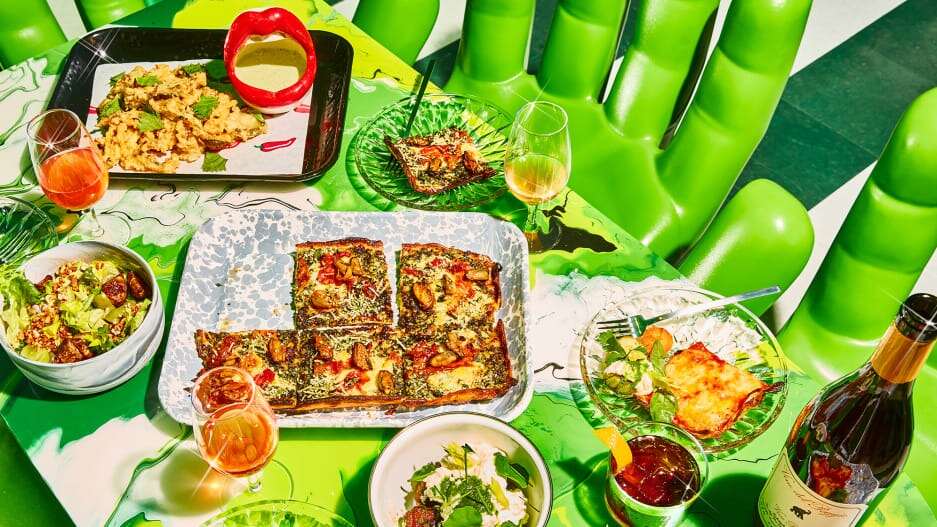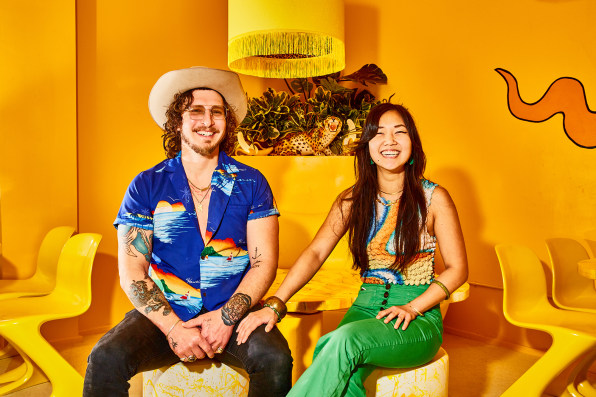- | 5:00 pm
At this restaurant, everything on the menu is made from trash
Shuggie’s Trash Pie builds its entire menu around food waste.

Every week for the past six weeks, the menu has changed at a San Francisco restaurant and wine bar called Shuggie’s Trash Pie. That’s because the ingredients depend in part on what farmers plan to throw out on any given day: The restaurant’s mission is to fight food waste.
When we spoke, they were expecting a delivery of a couple hundred pounds of surplus tomatoes that a farmer wouldn’t have otherwise been able to sell, and were planning to make a new tomato salad and sauce. The kitchen also creatively reuses ingredients within the restaurant; their pizza crust includes spent oats (a byproduct of the oat milk they make) and whey left over from making cheese. They look for waste in other parts of the supply chain, too—for example, they recently added a crudo to the menu made from swordfish belly. “Swordfish belly—and a lot of fish belly in general, which is a super coveted cut of fish—doesn’t get utilized in Western culture,” says chef and cofounder David Murphy. “It’s literally left on cutting room tables.”

Murphy and cofounder Kayla Abe previously started the Ugly Pickle Company, which makes “upcycled” snacks out of less-attractive vegetables that farmers have trouble selling. (The market for ugly produce has grown in the past few years, both from other packaged food companies and grocery delivery startups like Misfits Market.) While making pickles, they saw the opportunity to do more.
“Working with all of these local farmers, we really got to understand food waste and the many ways it manifests,” says Abe. “We saw that there was so much waste that we weren’t able to capture, mainly because food waste is unpredictable. . . . For this consumer packaged-good product, we needed some consistency and regularity with the type of produce that we’re using. People would come to us every week with requests like, ‘Can you pickle this? Can you use this in some way?’ We wanted to be able to capture a lot more of that.”
Shuggie’s Trash Pie opened in April, and after a couple of months of dealing with the usual challenges of starting a restaurant, the founders say they’re now able to focus on adapting to their suppliers, pivoting whenever something new appears.
They’re not the first chefs to call attention to the problem of food waste. In New York City, Dan Barber was an early pioneer with a pop-up in 2015 called Wasted that used food waste as ingredients. Massimo Bottura, the chef-owner of the three-Michelin-star restaurant Osteria Francescana in Modena, Italy, runs a network of soup kitchens that use food waste. Others try to incorporate food-saving techniques into their kitchens. Still, it’s unusual for a restaurant to focus completely on waste.
Not every item on Shuggie’s menu was previously destined for the landfill—it isn’t possible to buy upcycled pepperoni, for example, and Murphy chose to use a specific type of mozzarella on the pizzas. But every dish has three to five upcycled elements, and the other ingredients are as sustainable as possible and often sourced from local farms. “We’re going to the farmers market every Saturday and jam-packing our tiny car and filling our roof rack with things, just clown-car style,” Abe says.

Inside the restaurant, what you notice first isn’t the mission but the design, with vivid green and yellow furniture, including kitschy hand-shaped chairs. (As a San Francisco Chronicle review put it, the restaurant “turns food waste into a party.”) The price point for pizzas and appetizers is comparable to similar restaurants. The menu notes some of the unusual ingredients, like “wilty greens” and “underripe tomatoes,” though Abe says there’s so much to say that it doesn’t all get included. At the bottom, under a heading that says “food waste paradise,” they explain why it’s so important to do this. Between 30% and 40% of all the food grown in the U.S. is wasted. That’s not just a landfill problem, but a climate problem, and eliminating that waste could play a meaningful role in fighting climate change.
The founders want to help change what diners are willing to eat; the meatballs on the snack menu, for example, are made with beef heart, an offcut that Americans usually avoid. But the meatball “is freakin’ so good,” Murphy says, that it’s helped convert some customers.
They also want to inspire other restaurants to change. “Ultimately, we don’t want to be alone in this mission,” Abe says. “It’s exciting for us right now to be thinking this way, and kind of be first in some of these practices. But we want this just to be quite boring in the future, so that becomes just standard operating practice. Restaurants are notorious for being wasteful, especially in fine dining. . . . We’re trying to change that conversation.”






































